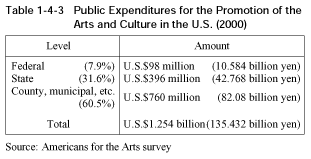| Home > Policy > White Paper, Notice, Announcement > White Paper > Japanese Government Policies in Education, Science, Sports and Culture 2000 > Part 1 Chapter 4 Section 2 1 | ||
In the United States, the functions of government, particularly the federal government, have traditionally been limited. In addition, it is considered the natural role of the rich to return to society the wealth they have built up in the form of donations. These characteristics also pertain to cultural administration. Regarding the promotion and preservation of the arts, assistance efforts by private citizens and organizations, including the collection of works of art, the building of museums, concert halls and other buildings, and the offering of economic assistance to artists by wealthy individuals such as Andrew Carnegie and Andrew Mellon, have been standard practice. On the other hand, the cultural role of the federal government has centered on measures that indirectly support culture, through the formulation of various measures, including favorable tax measures, in order to encourage and assist these contributions. Because of this tradition and the federal system itself, no department or agency in charge of cultural administration has been established in the federal government.
However, in 1965, the National Foundation on the Arts and the Humanities, an independent agency, was formed from the standpoint that there was a need for inquiry and coordination functions for national projects in arts, culture and the humanities. Under this Foundation, the National Endowment for the Arts (NEA) was set up as federal government agency with the goal of public support for the arts and cultural activities. The NEA's budget is allocated from the national budget, and the NEA is the central instrument for the promotion of the arts and culture and the preservation of culture carried out by the federal government.
There are also culture facilities that have been set up as independent cultural organizations by the federal government. These include the Smithsonian Institution, the National Gallery of Art, and the John F. Kennedy Center for the Performing Arts.
Assistance for cultural activities by local governments centers on NEA subsidies and arts councils of non-profit organizations that are operated by the budgets of state government and through private contributions. They provide support toward the expansion of opportunities for promotion of and enjoyment of the arts in each region. The states of New York and North Carolina have a longer history of providing subsidies that does the NEA. In addition, there are county and city arts councils that exist under the state arts councils. These local arts councils receive operating subsidies from the state arts council while working with the state and other local governments to provide a wide range of subsidies.
Regarding administration for protecting cultural assets as well, the system of distribution of powers to local governments is in place. The federal government is in charge of the preservation of important historic monuments and property considered by the Justice Department, etc., as items that should be protected from the standpoint of the country as a whole; the preservation of monuments that exist on land owned by the federal government; and the protection of buried cultural properties. Excluding these examples and others, the states handle a wide range of areas.
Public expenditures for the promotion of the arts and culture in the U.S. are shown in Table 1-4-3 .

There was also a time in the U.S. when the federal government hired artists and carried out cultural programs. After the Great Depression started in 1929, these activities were part of the so-called New Deal cultural programs, and were created mainly as measures to stimulate employment for artists. In the peak period, tens of thousands of artists were employed by the federal government. Projects of a type that had as yet not been carried out by the private sector were undertaken. They included the production of mural paintings and sculptures, the creation of the Index of American Design, arts education, the composition of symphonies, sponsorship of reasonably priced concerts, the writing and performance of dramatic plays, the production of guidebooks for all states; and the creation of an oral history archive. These projects had positive results. Various types of experimental works were created, playwrights who would go on to earn a place in history emerged and U.S. history was documented. Unfortunately, the theater project in particular became the target of criticism by Congress and other parties, and was severely reduced. The programs were discontinued in 1942 amid preparations for war. |
| Back to Top | MEXT HOME |